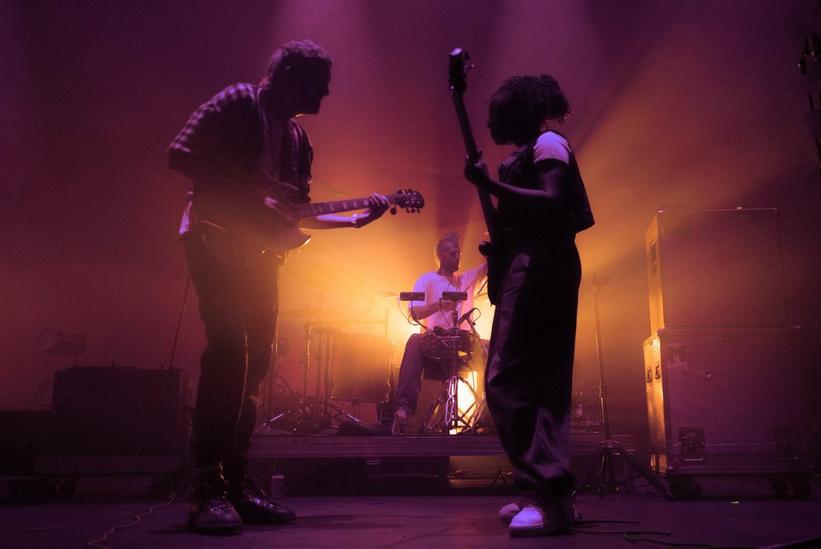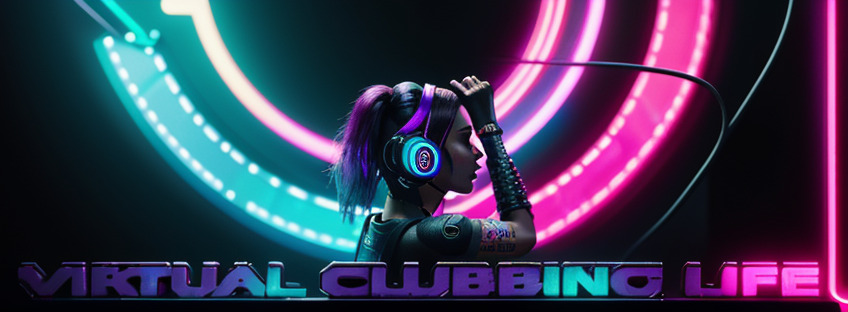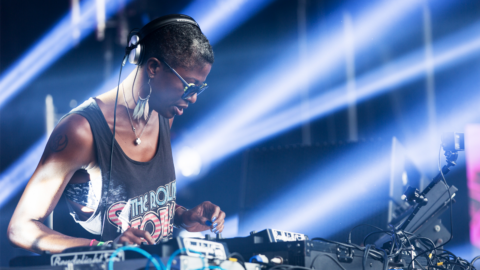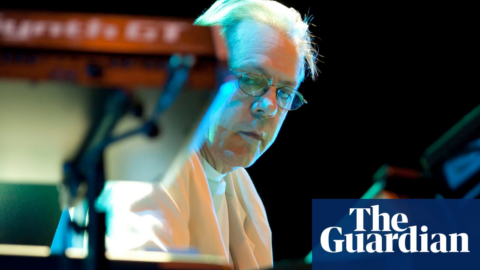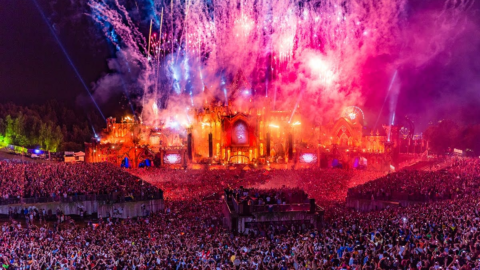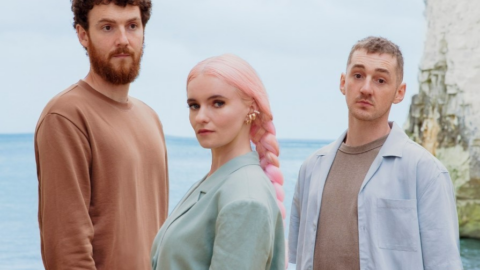Be the first to find out about GRAMMY nominees, winners, important news, and events. Privacy Policy
Photo: Rachel Kupfer
list
James Brown changed the sound of popular music when he found the power of the one and unleashed the funk with "Papa's Got a Brand New Bag." Today, funk lives on in many forms, including these exciting bands from across the world.
It's rare that a genre can be traced back to a single artist or group, but for funk, that was James Brown. The Godfather of Soul coined the phrase and style of playing known as "on the one," where the first downbeat is emphasized, instead of the typical second and fourth beats in pop, soul and other styles. As David Cheal eloquently explains, playing on the one "left space for phrases and riffs, often syncopated around the beat, creating an intricate, interlocking grid which could go on and on." You know a funky bassline when you hear it; its fat chords beg your body to get up and groove.
Brown's 1965 classic, "Papa's Got a Brand New Bag," became one of the first funk hits, and has been endlessly sampled and covered over the years, along with his other groovy tracks. Of course, many other funk acts followed in the '60s, and the genre thrived in the '70s and '80s as the disco craze came and went, and the originators of hip-hop and house music created new music from funk and disco's strong, flexible bones built for dancing.
Legendary funk bassist Bootsy Collins learned the power of the one from playing in Brown's band, and brought it to George Clinton, who created P-funk, an expansive, Afrofuturistic, psychedelic exploration of funk with his various bands and projects, including Parliament-Funkadelic. Both Collins and Clinton remain active and funkin', and have offered their timeless grooves to collabs with younger artists, including Kali Uchis, Silk Sonic, and Omar Apollo; and Kendrick Lamar, Flying Lotus, and Thundercat, respectively.
In the 1980s, electro-funk was born when artists like Afrika Bambaataa, Man Parrish, and Egyptian Lover began making futuristic beats with the Roland TR-808 drum machine — often with robotic vocals distorted through a talk box. A key distinguishing factor of electro-funk is a de-emphasis on vocals, with more phrases than choruses and verses. The sound influenced contemporaneous hip-hop, funk and electronica, along with acts around the globe, while current acts like Chromeo, DJ Stingray, and even Egyptian Lover himself keep electro-funk alive and well.
Today, funk lives in many places, with its heavy bass and syncopated grooves finding way into many nooks and crannies of music. There's nu-disco and boogie funk, nodding back to disco bands with soaring vocals and dance floor-designed instrumentation. G-funk continues to influence Los Angeles hip-hop, with innovative artists like Dam-Funk and Channel Tres bringing the funk and G-funk, into electro territory. Funk and disco-centered '70s revival is definitely having a moment, with acts like Ghost Funk Orchestra and Parcels, while its sparkly sprinklings can be heard in pop from Dua Lipa, Doja Cat, and, in full "Soul Train" character, Silk Sonic. There are also acts making dreamy, atmospheric music with a solid dose of funk, such as Khruangbin’s global sonic collage.
There are many bands that play heavily with funk, creating lush grooves designed to get you moving. Read on for a taste of five current modern funk and nu-disco artists making band-led uptempo funk built for the dance floor. Be sure to press play on the Spotify playlist above, and check out GRAMMY.com's playlist on Apple Music, Amazon Music and Pandora.
Aptly self-described as "discodelic soul," Brooklyn-based seven-piece Say She She make dreamy, operatic funk, led by singer-songwriters Nya Gazelle Brown, Piya Malik and Sabrina Mileo Cunningham. Their '70s girl group-inspired vocal harmonies echo, sooth and enchant as they cover poignant topics with feminist flair.
While they’ve been active in the New York scene for a few years, they’ve gained wider acclaim for the irresistible music they began releasing this year, including their debut album, Prism. Their 2022 debut single "Forget Me Not" is an ode to ground-breaking New York art collective Guerilla Girls, and "Norma" is their protest anthem in response to the news that Roe vs. Wade could be (and was) overturned. The band name is a nod to funk legend Nile Rodgers, from the "Le freak, c'est chi" exclamation in Chic's legendary tune "Le Freak."
Moniquea's unique voice oozes confidence, yet invites you in to dance with her to the super funky boogie rhythms. The Pasadena, California artist was raised on funk music; her mom was in a cover band that would play classics like Aretha Franklin’s "Get It Right" and Gladys Knight’s "Love Overboard." Moniquea released her first boogie funk track at 20 and, in 2011, met local producer XL Middelton — a bonafide purveyor of funk. She's been a star artist on his MoFunk Records ever since, and they've collabed on countless tracks, channeling West Coast energy with a heavy dose of G-funk, sunny lyrics and upbeat, roller disco-ready rhythms.
Her latest release is an upbeat nod to classic West Coast funk, produced by Middleton, and follows her February 2022 groovy, collab-filled album, On Repeat.
Shiro Schwarz is a Mexico City-based duo, consisting of Pammela Rojas and Rafael Marfil, who helped establish a modern funk scene in the richly creative Mexican metropolis. On "Electrify" — originally released in 2016 on Fat Beats Records and reissued in 2021 by MoFunk — Shiro Schwarz's vocals playfully contrast each other, floating over an insistent, upbeat bassline and an '80s throwback electro-funk rhythm with synth flourishes.
Their music manages to be both nostalgic and futuristic — and impossible to sit still to. 2021 single "Be Kind" is sweet, mellow and groovy, perfect chic lounge funk. Shiro Schwarz’s latest track, the joyfully nostalgic "Hey DJ," is a collab with funkstress Saucy Lady and U-Key.
L'Impératrice (the empress in French) are a six-piece Parisian group serving an infectiously joyful blend of French pop, nu-disco, funk and psychedelia. Flore Benguigui's vocals are light and dreamy, yet commanding of your attention, while lyrics have a feminist touch.
During their energetic live sets, L'Impératrice members Charles de Boisseguin and Hagni Gwon (keys), David Gaugué (bass), Achille Trocellier (guitar), and Tom Daveau (drums) deliver extended instrumental jam sessions to expand and connect their music. Gaugué emphasizes the thick funky bass, and Benguigui jumps around the stage while sounding like an angel. L’Impératrice’s latest album, 2021’s Tako Tsubo, is a sunny, playful French disco journey.
Franc Moody's bio fittingly describes their music as "a soul funk and cosmic disco sound." The London outfit was birthed by friends Ned Franc and Jon Moody in the early 2010s, when they were living together and throwing parties in North London's warehouse scene. In 2017, the group grew to six members, including singer and multi-instrumentalist Amber-Simone.
Their music feels at home with other electro-pop bands like fellow Londoners Jungle and Aussie act Parcels. While much of it is upbeat and euphoric, Franc Moody also dips into the more chilled, dreamy realm, such as the vibey, sultry title track from their recently released Into the Ether.
The Rise Of Underground House: How Artists Like Fisher & Acraze Have Taken Tech House, Other Electronic Genres From Indie To EDC
Photo: Steven Sebring
interview
"One foot in the past and one foot into the future," Billy Idol says, describing his decade-spanning career in rock. "We’ve got the best of all possible worlds because that has been the modus operandi of Billy Idol."
Living Legends is a series that spotlights icons in music still going strong today. This week, GRAMMY.com spoke with Billy Idol about his latest EP, Cage, and continuing to rock through decades of changing tastes.
Billy Idol is a true rock 'n' roll survivor who has persevered through cultural shifts and personal struggles. While some may think of Idol solely for "Rebel Yell" and "White Wedding," the singer's musical influences span genres and many of his tunes are less turbo-charged than his '80s hits would belie.
Idol first made a splash in the latter half of the '70s with the British punk band Generation X. In the '80s, he went on to a solo career combining rock, pop, and punk into a distinct sound that transformed him and his musical partner, guitarist Steve Stevens, into icons. They have racked up multiple GRAMMY nominations, in addition to one gold, one double platinum, and four platinum albums thanks to hits like "Cradle Of Love," "Flesh For Fantasy," and "Eyes Without A Face."
But, unlike many legacy artists, Idol is anything but a relic. Billy continues to produce vital Idol music by collaborating with producers and songwriters — including Miley Cyrus — who share his forward-thinking vision. He will play a five-show Vegas residency in November, and filmmaker Jonas Akerlund is working on a documentary about Idol’s life.
His latest release is Cage, the second in a trilogy of annual four-song EPs. The title track is a classic Billy Idol banger expressing the desire to free himself from personal constraints and live a better life. Other tracks on Cage incorporate metallic riffing and funky R&B grooves.
Idol continues to reckon with his demons — they both grappled with addiction during the '80s — and the singer is open about those struggles on the record and the page. (Idol's 2014 memoir Dancing With Myself, details a 1990 motorcycle accident that nearly claimed a leg, and how becoming a father steered him to reject hard drugs. "Bitter Taste," from his last EP, The Roadside, reflects on surviving the accident.)
Although Idol and Stevens split in the late '80s — the skilled guitarist fronted Steve Stevens & The Atomic Playboys, and collaborated with Michael Jackson, Rick Ocasek, Vince Neil, and Harold Faltermeyer (on the GRAMMY-winning "Top Gun Anthem") — their common history and shared musical bond has been undeniable. The duo reunited in 2001 for an episode of "VH1 Storytellers" and have been back in the saddle for two decades. Their union remains one of the strongest collaborations in rock 'n roll history.
While there is recognizable personnel and a distinguishable sound throughout a lot of his work, Billy Idol has always pushed himself to try different things. Idol discusses his musical journey, his desire to constantly move forward, and the strong connection that he shares with Stevens.
Steve has said that you like to mix up a variety of styles, yet everyone assumes you're the "Rebel Yell"/"White Wedding" guy. But if they really listen to your catalog, it's vastly different.
Yeah, that's right. With someone like Steve Stevens, and then back in the day Keith Forsey producing… [Before that] Generation X actually did move around inside punk rock. We didn't stay doing just the Ramones two-minute music. We actually did a seven-minute song. [Laughs]. We did always mix things up.
Then when I got into my solo career, that was the fun of it. With someone like Steve, I knew what he could do. I could see whatever we needed to do, we could nail it. The world was my oyster musically.
"Cage" is a classic-sounding Billy Idol rocker, then "Running From The Ghost" is almost metal, like what the Devil's Playground album was like back in the mid-2000s. "Miss Nobody" comes out of nowhere with this pop/R&B flavor. What inspired that?
We really hadn't done anything like that since something like "Flesh For Fantasy" [which] had a bit of an R&B thing about it. Back in the early days of Billy Idol, "Hot In The City" and "Mony Mony" had girls [singing] on the backgrounds.
We always had a bit of R&B really, so it was actually fun to revisit that. We just hadn't done anything really quite like that for a long time. That was one of the reasons to work with someone like Sam Hollander [for the song "Rita Hayworth"] on The Roadside. We knew we could go [with him] into an R&B world, and he's a great songwriter and producer. That's the fun of music really, trying out these things and seeing if you can make them stick.
I listen to new music by veteran artists and debate that with some people. I'm sure you have those fans that want their nostalgia, and then there are some people who will embrace the newer stuff. Do you find it’s a challenge to reach people with new songs?
Obviously, what we're looking for is, how do we somehow have one foot in the past and one foot into the future? We’ve got the best of all possible worlds because that has been the modus operandi of Billy Idol.
You want to do things that are true to you, and you don't just want to try and do things that you're seeing there in the charts today. I think that we're achieving it with things like "Running From The Ghost" and "Cage" on this new EP. I think we’re managing to do both in a way.
Obviously, "Running From The Ghost" is about addiction, all the stuff that you went through, and in "Cage" you’re talking about freeing yourself from a lot of personal shackles. Was there any one moment in your life that made you really thought I have to not let this weigh me down anymore?
I mean, things like the motorcycle accident I had, that was a bit of a wake up call way back. It was 32 years ago. But there were things like that, years ago, that gradually made me think about what I was doing with my life. I didn't want to ruin it, really. I didn't want to throw it away, and it made [me] be less cavalier.
I had to say to myself, about the drugs and stuff, that I've been there and I've done it. There’s no point in carrying on doing it. You couldn't get any higher. You didn't want to throw your life away casually, and I was close to doing that. It took me a bit of time, but then gradually I was able to get control of myself to a certain extent [with] drugs and everything. And I think Steve's done the same thing. We're on a similar path really, which has been great because we're in the same boat in terms of lyrics and stuff.
So a lot of things like that were wake up calls. Even having grandchildren and just watching my daughter enlarging her family and everything; it just makes you really positive about things and want to show a positive side to how you're feeling, about where you're going. We've lived with the demons so long, we've found a way to live with them. We found a way to be at peace with our demons, in a way. Maybe not completely, but certainly to where we’re enjoying what we do and excited about it.
[When writing] "Running From The Ghost" it was easy to go, what was the ghost for us? At one point, we were very drug addicted in the '80s. And Steve in particular is super sober [now]. I mean, I still vape pot and stuff. I don’t know how he’s doing it, but it’s incredible. All I want to be able to do is have a couple of glasses of wine at a restaurant or something. I can do that now.
I think working with people that are super talented, you just feel confident. That is a big reason why you open up and express yourself more because you feel comfortable with what's around you.
Did you watch Danny Boyle's recent Sex Pistols mini-series?
I did, yes.
You had a couple of cameos; well, an actor who portrayed you did. How did you react to it? How accurate do you think it was in portraying that particular time period?
I love Jonesy’s book, I thought his book was incredible. It's probably one of the best bio books really. It was incredible and so open. I was looking forward to that a lot.
It was as if [the show] kind of stayed with Steve [Jones’ memoir] about halfway through, and then departed from it. [John] Lydon, for instance, was never someone I ever saw acting out; he's more like that today. I never saw him do something like jump up in the room and run around going crazy. The only time I saw him ever do that was when they signed the recording deal with Virgin in front of Buckingham Palace. Whereas Sid Vicious was always acting out; he was always doing something in a horrible way or shouting at someone. I don't remember John being like that. I remember him being much more introverted.
But then I watched interviews with some of the actors about coming to grips with the parts they were playing. And they were saying, we knew punk rock happened but just didn't know any of the details. So I thought well, there you go. If ["Pistol" is] informing a lot of people who wouldn't know anything about punk rock, maybe that's what's good about it.
Maybe down the road John Lydon will get the chance to do John's version of the Pistols story. Maybe someone will go a lot deeper into it and it won't be so surface. But maybe you needed this just to get people back in the flow.
We had punk and metal over here in the States, but it feels like England it was legitimately more dangerous. British society was much more rigid.
It never went [as] mega in America. It went big in England. It exploded when the Pistols did that interview with [TV host Bill] Grundy, that lorry truck driver put his boot through his own TV, and all the national papers had "the filth and the fury" [headlines].
We went from being unknown to being known overnight. We waited a year, Generation X. We even told them [record labels] no for nine months to a year. Every record company wanted their own punk rock group. So it went really mega in England, and it affected the whole country – the style, the fashions, everything. I mean, the Ramones were massive in England. Devo had a No. 1 song [in England] with "Satisfaction" in '77. Actually, Devo was as big as or bigger than the Pistols.
You were ahead of the pop-punk thing that happened in the late '90s, and a lot of it became tongue-in-cheek by then. It didn't have the same sense of rebelliousness as the original movement. It was more pop.
It had become a style. There was a famous book in England called Revolt Into Style — and that's what had happened, a revolt that turned into style which then they were able to duplicate in their own way. Even recently, Billie Joe [Armstrong] did his own version of "Gimme Some Truth," the Lennon song we covered way back in 1977.
When we initially were making [punk] music, it hadn't become accepted yet. It was still dangerous and turned into a style that people were used to. We were still breaking barriers.
You have a band called Generation Sex with Steve Jones and Paul Cook. I assume you all have an easier time playing Pistols and Gen X songs together now and not worrying about getting spit on like back in the '70s?
Yeah, definitely. When I got to America I told the group I was putting it together, "No one spits at the audience."
We had five years of being spat on [in the UK], and it was revolting. And they spat at you if they liked you. If they didn't like it they smashed your gear up. One night, I remember I saw blood on my T-shirt, and I think Joe Strummer got meningitis when spit went in his mouth.
You had to go through a lot to become successful, it wasn't like you just kind of got up there and did a couple of gigs. I don't think some young rock bands really get that today.
With punk going so mega in England, we definitely got a leg up. We still had a lot of work to get where we got to, and rightly so because you find out that you need to do that. A lot of groups in the old days would be together three to five years before they ever made a record, and that time is really important. In a way, what was great about punk rock for me was it was very much a learning period. I really learned a lot [about] recording music and being in a group and even writing songs.
Then when I came to America, it was a flow, really. I also really started to know what I wanted Billy Idol to be. It took me a little bit, but I kind of knew what I wanted Billy Idol to be. And even that took a while to let it marinate.
You and Miley Cyrus have developed a good working relationship in the last several years. How do you think her fans have responded to you, and your fans have responded to her?
I think they're into it. It's more the record company that she had didn't really get "Night Crawling"— it was one of the best songs on Plastic Hearts, and I don't think they understood that. They wanted to go with Dua Lipa, they wanted to go with the modern, young acts, and I don't think they realized that that song was resonating with her fans. Which is a shame really because, with Andrew Watt producing, it's a hit song.
But at the same time, I enjoyed doing it. It came out really good and it's very Billy Idol. In fact, I think it’s more Billy Idol than Miley Cyrus. I think it shows you where Andrew Watt was. He was excited about doing a Billy Idol track. She's fun to work with. She’s a really great person and she works at her singing — I watched her rehearsing for the Super Bowl performance she gave. She rehearsed all Saturday morning, all Saturday afternoon, and Sunday morning and it was that afternoon. I have to admire her fortitude. She really cares.
I remember when you went on "Viva La Bam" back in 2005 and decided to give Bam Margera’s Lamborghini a new sunroof by taking a power saw to it. Did he own that car? Was that a rental?
I think it was his car.
Did he get over it later on?
He loved it. [Laughs] He’s got a wacky sense of humor. He’s fantastic, actually. I’m really sorry to see what he's been going through just lately. He's going through a lot, and I wish him the best. He's a fantastic person, and it's a shame that he's struggling so much with his addictions. I know what it's like. It's not easy.
Musically, what is the synergy like with you guys during the past 10 years, doing Kings and Queens of the Underground and this new stuff? What is your working relationship like now in this more sober, older, mature version of you two as opposed to what it was like back in the '80s?
In lots of ways it’s not so different because we always wrote the songs together, we always talked about what we're going to do together. It was just that we were getting high at the same time.We're just not getting [that way now] but we're doing all the same things.
We're still talking about things, still [planning] things:What are we going to do next? How are we going to find new people to work with? We want to find new producers. Let's be a little bit more timely about putting stuff out.That part of our relationship is the same, you know what I mean? That never got affected. We just happened to be overloading in the '80s.
The relationship’s… matured and it's carrying on being fruitful, and I think that's pretty amazing. Really, most people don't get to this place. Usually, they hate each other by now. [Laughs] We also give each other space. We're not stopping each other doing things outside of what we’re working on together. All of that enables us to carry on working together. I love and admire him. I respect him. He's been fantastic. I mean, just standing there on stage with him is always a treat. And he’s got an immensely great sense of humor. I think that's another reason why we can hang together after all this time because we've got the sense of humor to enable us to go forward.
There's a lot of fan reaction videos online, and I noticed a lot of younger women like "Rebel Yell" because, unlike a lot of other '80s alpha male rock tunes, you're talking about satisfying your lover.
It was about my girlfriend at the time, Perri Lister. It was about how great I thought she was, how much I was in love with her, and how great women are, how powerful they are.
It was a bit of a feminist anthem in a weird way. It was all about how relationships can free you and add a lot to your life. It was a cry of love, nothing to do with the Civil War or anything like that. Perri was a big part of my life, a big part of being Billy Idol. I wanted to write about it. I'm glad that's the effect.
Is there something you hope people get out of the songs you've been doing over the last 10 years? Do you find yourself putting out a message that keeps repeating?
Well, I suppose, if anything, is that you can come to terms with your life, you can keep a hold of it. You can work your dreams into reality in a way and, look, a million years later, still be enjoying it.
The only reason I'm singing about getting out of the cage is because I kicked out of the cage years ago. I joined Generation X when I said to my parents, "I'm leaving university, and I'm joining a punk rock group." And they didn't even know what a punk rock group was. Years ago, I’d write things for myself that put me on this path, so that maybe in 2022 I could sing something like "Cage" and be owning this territory and really having a good time. This is the life I wanted.
The original UK punk movement challenged societal norms. Despite all the craziness going on throughout the world, it seems like a lot of modern rock bands are afraid to do what you guys were doing. Do you think we'll see a shift in that?
Yeah. Art usually reacts to things, so I would think eventually there will be a massive reaction to the pop music that’s taken over — the middle of the road music, and then this kind of right wing politics. There will be a massive reaction if there's not already one. I don’t know where it will come from exactly. You never know who's gonna do [it].
Living Legends: Nancy Sinatra Reflects On Creating "Power And Magic" In Studio, Developing A Legacy Beyond "Boots" & The Pop Stars She Wants To Work With
Graphic: The Recording Academy
list
The 2023 GRAMMY Award nominees for Best Country Solo Performance highlight country music's newcomers and veterans, featuring hits from Kelsea Ballerini, Zach Bryan, Miranda Lambert, Maren Morris and Willie Nelson.
Country music's evolution is well represented in the 2023 GRAMMY nominees for Best Country Solo Performance. From crossover pop hooks to red-dirt outlaw roots, the genre's most celebrated elements are on full display — thanks to rising stars, leading ladies and country icons.
Longtime hitmaker Miranda Lambert delivered a soulful performance on the rootsy ballad "In His Arms," an arrangement as sparing as the windswept west Texas highlands where she co-wrote the song. Viral newcomer Zach Bryan dug into similar organic territory on the Oklahoma side of the Red River for "Something in the Orange," his voice accompanied with little more than an acoustic guitar.
Two of country's 2010s breakout stars are clearly still shining, too, as Maren Morris and Kelsea Ballerini both received Best Country Solo Performance GRAMMY nods. Morris channeled the determination that drove her leap-of-faith move from Texas to Nashville for the playful clap-along "Circles Around This Town," while Ballerini brought poppy hooks with a country edge on the infectiously upbeat "HEARTFIRST."
Rounding out the category is the one and only Willie Nelson, who paid tribute to his late friend Billy Joe Shaver with a cover of "Live Forever" — a fitting sentiment for the 89-year-old legend, who is approaching his eighth decade in the business.
As the excitement builds for the 2023 GRAMMYs on Feb. 5, 2023, let's take a closer look at this year's nominees for Best Country Solo Performance.
In the tradition of Shania Twain, Faith Hill and Carrie Underwood, Kelsea Ballerini represents Nashville's sunnier side — and her single "HEARTFIRST" is a slice of bright, uptempo, confectionary country-pop for the ages.
Ballerini sings about leaning into a carefree crush with her heart on her sleeve, pushing aside her reservations and taking a risk on love at first sight. The scene plays out in a bar room and a back seat, as she sweeps nimbly through the verses and into a shimmering chorus, when the narrator decides she's ready to "wake up in your T-shirt."
There are enough steel guitar licks to let you know you're listening to a country song, but the story and melody are universal. "HEARTFIRST" is Ballerini's third GRAMMY nod, but first in the Best Country Solo Performance category.
Zach Bryan blew into Music City seemingly from nowhere in 2017, when his original song "Heading South" — recorded on an iPhone — went viral. Then an active officer in the U.S. Navy, the Oklahoma native chased his muse through music during his downtime, striking a chord with country music fans on stark songs led by his acoustic guitar and affecting vocals.
After his honorable discharge in 2021, Bryan began his music career in earnest, and in 2022 released "Something in the Orange," a haunting ballad that stakes a convincing claim to the territory between Tyler Childers and Jason Isbell in both sonics and songwriting. Slashing slide guitar drives home the song's heartbreak, as Bryan pines for a lover whose tail lights have long since vanished over the horizon.
"Something In The Orange" marks Bryan's first-ever GRAMMY nomination.
Miranda Lambert is the rare, chart-topping contemporary country artist who does more than pay lip service to the genre's rural American roots. "In His Arms" originally surfaced on 2021's The Marfa Tapes, a casual recording Lambert made with Jack Ingram and Jon Randall in Marfa, Texas — a tiny arts enclave in the middle of the west Texas high desert.
In this proper studio version — recorded for her 2022 album, Palomino — Lambert retains the structure and organic feel of the mostly acoustic song; light percussion and soothing atmospherics keep her emotive vocals front and center. A native Texan herself, Lambert sounds fully at home on "In His Arms."
Lambert is the only Best Country Solo Performance nominee who is nominated in all four Country Field categories in 2023. To date, Miranda Lambert has won 3 GRAMMYs and received 27 nominations overall.
When Maren Morris found herself uninspired and dealing with writer's block, she went back to what inspired her to move to Nashville nearly a decade ago — and out came "Circles Around This Town," the lead single from her 2022 album Humble Quest.
Written in one of her first in-person songwriting sessions since the pandemic, Morris has called "Circles Around This Town" her "most autobiographical song" to date; she even recreated her own teenage bedroom for the song's video. As she looks back to her Texas beginnings and the life she left for Nashville, Morris' voice soars over anthemic, yet easygoing production.
Morris last won a GRAMMY for Best Country Solo Performance in 2017, when her song "My Church" earned the singer her first GRAMMY. To date, Maren Morris has won one GRAMMY and received 17 nominations overall.
Country music icon Willie Nelson is no stranger to the GRAMMYs, and this year he aims to add to his collection of 10 gramophones. He earned another three nominations for 2023 — bringing his career total to 56 — including a Best Country Solo Performance nod for "Live Forever."
Nelson's performance of "Live Forever," the lead track of the 2022 tribute album Live Forever: A Tribute to Billy Joe Shaver, is a faithful rendition of Shaver's signature song. Still, Nelson puts his own twist on the tune, recruiting Lucinda Williams for backing vocals and echoing the melody with the inimitable tone of his nylon-string Martin guitar.
Shaver, an outlaw country pioneer who passed in 2020 at 81 years old, never had any hits of his own during his lifetime. But plenty of his songs were still heard, thanks to stars like Elvis Presley, Kris Kristofferson and Waylon Jennings. Nelson was a longtime friend and frequent collaborator of Shaver's — and now has a GRAMMY nom to show for it.
2023 GRAMMY Nominations: See The Complete Nominees List
Graphic: The Recording Academy
news
Ahead of Music's Biggest Night on Feb. 5, 2023, celebrate with this immersive playlist of every Latin Field nominee at the 2023 GRAMMYs.
The Latin GRAMMYs may have just honored the genre's trailblazers in Las Vegas on Nov. 17, but the celebration will continue at the upcoming 65th GRAMMY Awards ceremony in February. There are five categories in the Latin Field of the 2023 GRAMMY nominations — and you can hear all of the nominees in one playlist.
In the Best Latin Pop Album category, are Christina Aguilera's Latin GRAMMY-winning AGUILERA will compete with Rubén Blades & Boca Livre's Pasieros, Camilo's De Adendro Pa Afuera, Fonseca's VIAJANTE, and Sebastián Yatra's Dharma+. Channeling their lively Latin roots while traversing pop landscapes, these albums all magnetically merge tradition and modernity.
Reggaeton, dancehall, hip hop, and funk coalesce in the nominated works for Best Música Urbana Album: Rauw Alejandro's Trap Cake, Vol. 2, Bad Bunny's Un Verano Sin Ti, Daddy Yankee's LEGENDADDY, Farruko's La 167, and Maluma's The Love & Sex Tape.
The genre-blending jubilation continues with the Best Latin Rock or Alternative Album category. This year's nominees are Cimafunk's El Alimento, Jorge Drexler's Tinta y Tiempo, Mon Laferte's 1940 Carmen, Gaby Moreno's Alegoría, Fito Paez's Los Años Salvajes, and Rosalía's MOTOMAMI.
For Best Regional Mexican Music Album (Including Tejano), 2021 winner Natalia Lafourcade's Un Canto por México – El Musical is up against Chiquis' Abeja Reina, Los Tigres Del Norte's La Reunión (Deluxe), Christian Nodal's EP #1 Forajido, and Marco Antonio Solís' Qué Ganas de Verte (Deluxe).
As for Best Tropical Latin Album, Marc Anthony — a two-time winner in the category — returns as a nominee with Pa'lla Voy, alongside pioneers Tito Nieves (nominated for Legendario), La Santa Cecilia (Quiero Verte Feliz), Víctor Manuelle (Lado A Lado B), Spanish Harlem Orchestra (Imágenes Latinas), and Carlos Vives (Cumbiana II).
Listen to all of the above albums in this comprehensive, 338-song playlist of the Latin music GRAMMY nominees at the 2023 GRAMMYs.
Check it out on Pandora, Spotify, Apple Music, and Amazon Music — and we'll see you at Music's Biggest Night on Sunday, Feb. 5!
2023 GRAMMY Nominations: See The Complete Nominees List
Photo: Christian Butler
feature
"Dungeon synth is the music that you hear in your dreams," one artist says of the metal-adjacent subgenre that resurged during the pandemic. Do infighting, bad actors and Bandcamp oversaturation mean the dream will soon be over?
When Håvard Ellefsen surveys the world he helped create, he finds himself at a loss.
The irascible Norwegian artist, who records as Mortiis, can't explain why the grandiose, metal-adjacent subgenre he helped forge in the '90s, now known as "dungeon synth," "crawled out of the grave" after more than a decade of relative inertia.
Nor can he wrap his head around the plethora of sub-sub-subgenres — of highly variable degrees of sincerity and craft — that threaten to send it right back to the tomb.
"There's a thing called cozy synth? Dino synth? What the f—?" Ellefsen incredulously asks GRAMMY.com. "I mean, are you just taking the piss? If I want to f—ing get into dinosaurs, I'll talk to my 11-year-old son. He's into them and knows more about them than I do. I'll watch Jurassic Park!"
To him, dungeon synth means something — and the current crop of copycats and dilettantes saturating the internet threatens its integrity.
But what is it, exactly?
Mortiis. Photo: Ekaterina Gorbacheva
Think of the brief atmospheric interludes on black-metal albums, stretched to sprawling lengths. Think of chainmail and swordplay. Think of a half-remembered soundtrack to an MS-DOS version of The Lord of the Rings that may have never existed. (Although Ellefsen rejects this characterization, and clearly states that he has never pursued this in his own music, the younger guard interviewed for this article wholeheartedly embraces it.)
Above all, dungeon synth is profoundly transportive, deeply felt, shamelessly escapist, and sometimes uncomfortably earnest.
"For me, dungeon synth is the music that you hear in your dreams," says John Hartman, who runs Lightfall Records and performs under banners like Temple of the Fractured Light and Majesty of Oceans. "It's music that's so beautiful, you can't touch it."
While grunge reigned, the music now known as dungeon synth quietly sprang up in Europe and America alike. Bard Argol, who declines to use his real name for this article, also played a prominent role in forging this style; he founded the label Dark Age Productions in Minnesota all the way back in 1994.
But he, too, is perplexed as to where this subculture is headed.
"What the f— is this s—?" Bard Argol asks GRAMMY.com, citing the recent introduction of something called "hot dog synth." Wayfarer, who crafts immersive and expansive works as Fen Walker and Frost Clad, cites an album-length "dungeon synth" tribute to Guy Fieri, the goateed meme king of Diners, Drive-Ins and Dives fame.
"There's one guy who put out a pizza record," he adds. "It's really getting ridiculous."
To a degree, dungeon synth's old guard can roll with the trolls — or even troll them back. Bard Algol recently released a T-shirt emblazoned with a 17th-century illustration depicting a man with a peg-leg playing a keyboard. (The caption: "Uncomfy Synth.")
But on the main, they're concerned about where the music is headed. Because at press time, dungeon synth is in danger of becoming diluted beyond recognition — and, as a result, ruined.
If this renaissance falls apart completely, it will probably be due to Bandcamp's tagging system — where bad actors can call anything dungeon synth and get away with it. "The low barrier is starting to show," Hartman says.
To be fair, not all of the offshoots are provocative slop. For instance, the somewhat infamous 2019 eponymous debut by Grandma's Cottage has its defenders, on something of an ASMR level. Just as dungeon synth at its best can galvanize you to ride into battle, Grandma's Cottage can transport you to a shag rug by a crackling fire, munching ginger snaps.
But under dungeon synth's expanded umbrella, albums like that are the exception, not the rule.
"Grandma's Cottage and Diplodocus — I love both of those, but they spawned a slew of imitators that started saturating the Bandcamp tag," says Ross Major, who makes dungeon synth as Malfet and runs the Pacific Threnodies label. "It got tiresome for people to sift through so much of that to find needles in a haystack.
"The avalanche from 2018 to 2021," he concludes, "seems to have slowed."
If the current dungeon-synth wave recedes for good, it'll be a shame. Because beyond the quality of the music at its best, the community has a lot to be proud of.
During the pandemic, the visual-forward subculture (think atmospheric, fantasy-driven, and otherworldly) progressed from a steady climb to an explosion. Suddenly, a plethora of new followers were watching — and holding forth on — highly theatrical performances on Twitch.
With the world locked inside, these online "sieges" and "skirmishes" acted as a haven for all kinds of people not oriented toward the mainstream — neurotypical and neuroatypical; gender-conforming or non-.
"It feels amazing when we all get together, because we're all a bunch of nerds," Major says of post-vaccine, in-person gatherings like Northeast Dungeon Siege in Worcester, Massachusetts. "Most people that we encounter on the street are not going to 'get' what we're into. And it's awesome that it appears to be such a haven for that."
So, how can dungeon synth overcome its defects tinue to grow in a healthy and sustainable way? Maybe finding an answer begins with understanding where the music came from.
Which brings us back to Mortiis.
In 1992, Harvard Ellefsen was fired from Emperor — the symphonic black-metal royalty who went on to make masterpieces like 1994's In the Nightside Eclipse and 1997's Anthems to the Welkin at Dusk.
The next day, he walked to a music store, toted home a Roland keyboard, started making music, and began recording in early spring 1993 — thus laying the groundwork for Mortiis.
He'd planted the seeds for that sound a while ago. While Emperor was unquestionably dark, they achieved that darkness through conventional pop and rock instruments — guitar, bass and drums. Ellefsen wanted to get to that place through unorthodox methods.
This meant he bent his ear to outré acts outside the scope of metal — his biggest inspirations being Berlin School artists like Tangerine Dream and solo Klaus Schulze. Gloomier acts like Coil, Throbbing Gristle and Dead Can Dance were also in the mix. (Likewise, Bard Algol drew from a diverse array of inspirations early on, metal or otherwise — from Tangerine Dream's soundtrack to the Ridley Scott film Legend to first-wave black-metallers Venom, Bathory, and Beherit.)
"It [all] fit right in there next to Diamanda Galás or something, which was crazy, f—ing disturbing performance art," Ellefsen adds. "All of that stuff inspired me to do something that was different."
All these influences and more inspired Ellefsen to record the first Mortiis demo at his parents' house. Today, he looks back on an illustrious, three-decade career that has spanned many left-field subgenres, from dark ambient to industrial rock.
Mortiis' early output, as well as recent works like 2020's Spirit of Rebellion, typifies dungeon synth — even if the label was attached to his music retroactively. The closest he got to that tag was calling it "dark dungeon music"; a phrase he named his label after in the mid-'90s.
Around that time, fellow dungeon-synth architects Depressive Silence, Neptune Towers, and Wongraven emerged as well: Wayfarer calls acts like those "starter-pack dungeon synth." ("We all have that origin, it seems like," he says.)
Ellefsen may have a reputation as a curmudgeon among a few. But although he may aim his guns at poor Grandma and her cottage, he stops short of castigating the new guard outright.
Instead, he wonders about the well that younger musicians are drawing from.
Because Ellefsen drew from all over the dark-experimental map, the result was a nutritious mix of inspirations — which ultimately made his music satisfying and rangy.
However, "I'm not sure if the kids today are inspired by these things," he says. "Or if they're more into video games; I see that a lot." (Elsewhere, he calls the video-game-influenced component "corny.")
It's true that dungeon synth provides a suitably fantastical soundtrack to "Dark Souls" and its ilk. But for Major, this wasn't an end to itself; it came from an internal directive to "make personal music always."
"I love playing 'Skyrim,' and the 'Elder Scrolls' music is so beautiful to my ears," he says. "I like thinking about knights and fantasy, but also the deep forest and magic and the things I personally like. Maybe there'll be a few people who feel the same."
"Some people don't like the comparison to video game music, but I think it's at this rate, it's unavoidable," dungeon-synth musician Francis Roberts tells GRAMMY.com. "It's a big piece of how I got into the genre."
Gaming aside, Ellefsen questions the amount of effort that some contemporary acts put into their works, calling some of the cover art "deliberately sloppy."
"My feeling is that there's something a little tongue-in-cheek about it, even though some of the folks probably would not acknowledge that," Adam Matlock, who records dungeon synth as Erszébet, Dust Seeker and other monikers, tells GRAMMY.com. "But it gives it [that quality] where it doesn't feel cynical."
"I don't really care, because I don't make the rules," Ellefsen says about the frivolity he perceives in today's dungeon synth. "But when I started out, I was really f—ing serious."
Adam Matlock. Photo: Eliza Caldwell
There is one glaring reason why dungeon-synth neophytes might disregard their roots. Because one of the building blocks of the music was the infamous Burzum.
In the early '90s, under that name, Varg Vikernes made foundational works of early black metal, as well as minimal, meandering synthesizer music — much of the latter while serving 16 years in prison for the arson of three churches and murder of his bandmate.
But these days, Vikernes is persona non grata in the metal world — in large part due to Neo-Nazi sympathies. Despite Burzum's influence on dungeon synth's development, nobody's going to sing Vikernes' praises and stay in the scene's good graces while they're at it.
"I wasn't going to mention Burzum, because the guy is nuts," Ellefsen says. (In a recent podcast, he called him "the biggest f—ing a—hole on the planet.)
That's a positive break from the past; half-baked, parodic spinoffs, less so. As such, it's worth highlighting artists who retrieve value from the past while discarding its refuse — and maintain bound to tradition without being beholden to it.
Can dungeon synth's endless permutations come off as intimidating? That's natural, Wayfarer says, given the nature of its taxonomy.
"How many subgenres are there in metal? It goes on for infinity," he says. "You have all the -cores, and you have all the 'blackeneds'… it only makes sense that something born out of metal has a million subgenres."
These designations aside, what are the cornerstones of dungeon synth, past and present? Rather than fruitlessly search for the good stuff in a sea of spam, it's helpful to let the leading musicians offer some gateways.
Among Wayfarer's cornerstones of the form — from any era — are the Torchlight's supremely atmospheric The Long Quest and Guild of Lore's Storm Haven. Cernunnos Woods' Awaken the Empire of Dark Wood is "a very early release — very cool stuff." Casket of Dreams' Dragons of Autumn Twilight is "just fantastic — a big influence on me as well."
For Hartman, the quintessential dungeon-synth album is Spheres of Time by Solanum. "There is not a release that encapsulates that feeling of nostalgia, dreaminess and being in another world than Spheres of Time," he says. He also praises Fen Walker for "incorporating tribal and psychedelic elements."
"I always connect the best to the music my friends make, so it's hard for me to be very objective," Major says. That said, he's digging the Virginian artist Vaelastrasz; Vale Minstrel, who has a "more upbeat, medieval-bard-sounding style"; and Ulk, a project from the Netherlands on Gondolin Records.
"They're all themed around tortoises," Major describes of Ulk's releases. "But there's a combination. It's not terribly dark. It is lo-fi, but the playing and composition are very masterful. It's almost like if Claude Debussy had a Casio keyboard and an eight-track."
"It sounds egotistical, but I would say my own stuff was one of the more defining things of the era," Bard Algol says. To this end, he also cites releases by Valor, Equitant and the Soil Bleeds Black.
Sometimes, it can seem miraculous that dungeon synth ever came back at all — much less became a sensation in the 2020s.
"The impression I get is that it was like some kind of old vampire that got stabbed and f—ing beheaded, and it's just been laying rotting for 25 years," Ellefsen says. "Now, it's back, crawling back out of the f—ing rotten ground, foggy and s—."
To this progenitor of the form, what's the best way to keep it going in a pizza-less, Fieri-less form — one with at least some fidelity to its roots? What would he tell a young person who loves this music, has applied a harpsichord patch to their microKORG, and wants to make dungeon synth themselves?
"The first thing I would say is that they don't have to use the harpsichord." Ellefsen continues, while clarifying that he's incorporated the sound into some of his work. "There's a lot of: Let's go to the medieval fair now and get dressed up and drink mead… there are so many other ways to create atmospheric music."
To Hartman, preserving the integrity of the form doesn't mean inflexible devotion to a predetermined aesthetic; it just means holding music to a certain standard. "Dungeon synth needs to start guarding its gate a little bit tighter — not a lot tighter, but a little bit tighter," he says. "It needs to be very honest and even helpful with its criticism of things."
This also might mean expanding the boundaries of dungeon synth — in a way that doesn't lead to trollish offshoots that uncontrollably replicate like cancer cells.
He brings up his Temple of the Fractured Light album called PSYOP Theory, about UFOs, the pyramid's eye, and other conspiratorial topics. "Then, someone was like, 'Oh man, conspiracy synth!' I'm interested!'" Hartman says. "No, this is not a new thing. This is not a new genre. Not everything needs 'synth' strapped to it like a rocket."
Nonetheless, he believes these adjustments alone won't staunch the bleeding: "I think the cat's out of the bag," Hartman says.
As several artists concede, attitudes within this very online community could also use some work — not only in tamping down the infighting inherent to every subculture, but being honest with oneself and others regarding the quality of the output.
"You don't really get any sort of honest criticism about your music. It's kind of passive-aggressive, in a way," Wayfarer says. Too often, he said he sends his works to others, and is met with "It's perfect."
"No, I'm asking you because I want you to tell me, 'Yo, that's off-time. That doesn't sound good. That lead's garbage.'" he continues. "I want to crystallize my work, and I need fresh ears to make that happen." He extends this frustration to dungeon-synth blogs, which too often simply ignore records they don't like rather than offering constructive criticism.
The elephant in the room comes up once again — albeit abstractly.
"It's the endless clash over ideology, national-socialist junk. And you think it's a no-brainer." Wayfarer says. "But it's more nuanced than that: OK, this album isn't about Nazis. It's about forests and it's about castles and vampires and mystery and whatever," he adds. "But the dudes making this music are total racist a—holes."
"We don't want your Nazi stuff in our music scene," Wayfarer adds, with a spirited "F— off."
Francis Roberts. Photo: Jaz Diaz
All this dissonance aside, there are encouraging signs that dungeon synth can continue to grow in a positive manner. For instance, Thorsten Quaeschning — Edgar Froese's appointed successor at the helm of German electronic pioneers Tangerine Dream — headlined the last Dungeon Siege streaming event.
"He does these improvisational sets, and apparently, he went on a deep dive and listened to a bunch of dungeon synth beforehand," Major notes. "And you could tell, because it was like Tangerine Dream with martial overdones. There were moments that sounded like timpani strikes, and little folkish melodies. It was so awesome."
Roberts wonders if this sort of crossover could extend all the way into the mainstream. Of all artists, Lil Nas X comes to mind.
"You hear all kinds of incredible songs built from samples you wouldn't expect. 'Old Town Road' is a great example of that — some obscure Nine Inch Nails B-side turned into the pop anthem of the decade," he says. "I could see something like that happening, where someone is making dungeon synth, and one of their friends is making beats for pop artists, and then one of those people blows up."
Although, he concedes, "that would probably be infuriating for the people that make this stuff."
It's worth noting that the Recording Academy recently expanded the GRAMMYs' Best New Age Album category into Best New Age, Ambient Or Chant Album, which could provide a platform for dungeon synth, or adjacent genres, to flourish on the world stage.
But whether or not that mainstream leap transpires, the fate of dungeon synth will rest on the shoulders of artists who bring creativity, flair, and emotional vulnerability to their craft.
Ellefsen, for one, is still evolving his craft and performing live, and supporting emerging dungeon-synth talent along the way.
This has led to wonderfully surreal moments, like Mortiis and Malfet packing out the Graduate, a now-defunct college bar in San Luis Obispo, a tiny college town off the 101 on the Central Coast of California.
And after lockdowns receded, Malfet performed in an even wilder venue for dungeon synth: the Raconteur Room, a tiny craft-beer-and-music joint in adjacent, rural Atascadero, where you'd usually hear the pluck of a capoed Ovation acoustic guitar.
Among the 50 or 60 attendees were Major's oldest friends — ones who had zero interest in, or awareness of, this niche, fantasy world. But after his performance, the folks who wouldn't know Old Tower from Erang were sold.
"It's a folk-rock bar. It's Atascadero," Major recalls in awe. "But when I finished, they were chanting: 'Dungeon synth! Dungeon synth! Dungeon synth! Encore!'"
"And I played an encore," he says.
Like Turnstile And Code Orange? 10 More Bands Expanding The Boundaries Of Hardcore
RECORDING ACADEMY
MEMBERSHIP
GRAMMYS
ADVOCACY
MUSICARES
LATIN GRAMMYS
GRAMMY MUSEUM
@ 2022 – Recording Academy. All rights reserved.
Some of the content on this site expresses viewpoints and opinions that are not those of the Recording Academy and its Affiliates. Responsibility for the accuracy of information provided in stories not written by or specifically prepared for the Academy and its Affiliates lies with the story's original source or writer. Content on this site does not reflect an endorsement or recommendation of any artist or music by the Recording Academy and its Affiliates.
